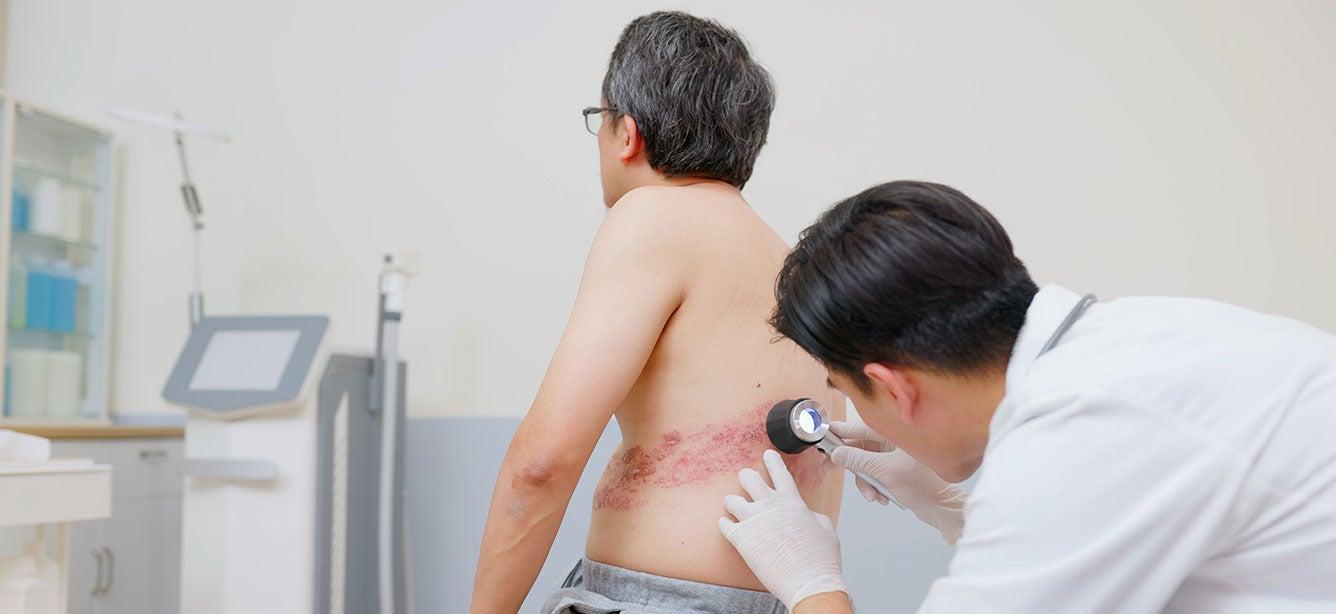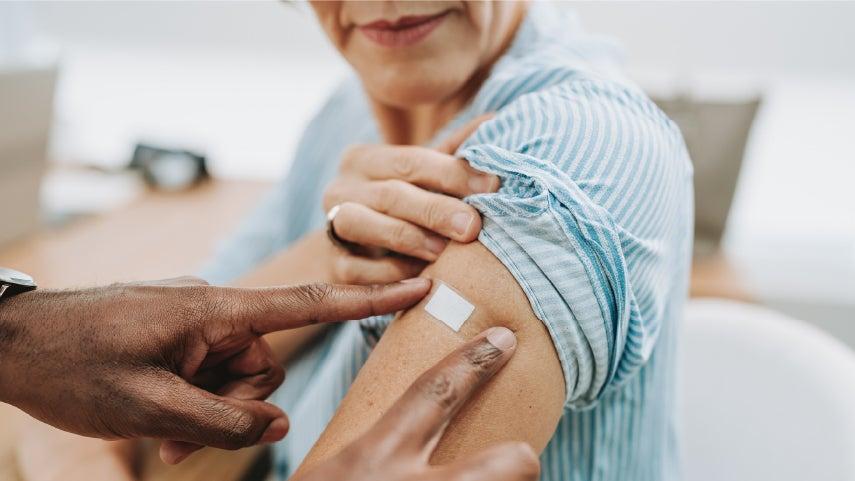
Related Topics
Doctors strongly recommend that adults 50 and older get the shingles vaccine to help prevent the painful and sometimes debilitating condition. And after getting shingles in 2023, 88-year-old Jim H., of Bucks County, Pennsylvania, strongly agrees.
His case of shingles began on his chest—as “red blotches that started to have some small bubbles”—and lasted between four to five weeks. Still, he considers himself lucky: “I had a pretty mild case of it as far as the pain that other people have experienced.”
But he knows the effects of shingles can be serious. And although it is rare to get shingles twice, it is possible to get it again.1 “Get your shingles vaccination,” Jim said. He has since gotten his.
“A pound of prevention is worth, honestly, pounds of cure,” Georges Benjamin, MD, executive director of the American Public Health Association (APHA), said in an interview.
People should not take it (shingles) lightly. It’s not just a rash.”
So, what is shingles, and what should you do if you are among the approximately 1 million people in the U.S. who get the virus each year?2 Let’s explore the answers to these and other questions you may have about shingles.
What is shingles?
Shingles (herpes zoster) is a viral infection that causes a painful, blistering rash and other symptoms. Shingles is caused by the varicella-zoster virus (VZV), which is the virus that causes chickenpox.
“Anyone who has had chickenpox has this virus,” the American Academy of Dermatology Association (AAD) explains on its website. “After you recover from chickenpox, the virus moves to nerves inside your body, where it goes to sleep. You will always have the virus inside your body. If the virus wakes up, you get shingles.”3
About 1 in 3 people who have had chicken pox will get shingles.2 Most people who get shingles are over the age of 50.4
That’s why the two-dose Shingrix vaccine is recommended for people 50 and older. Vaccination is also recommended for some adults age 19 and older who have compromised immune systems. The Centers for Disease Control and Prevention (CDC) says Shingrix—which is the only shingles vaccine available in the U.S.—can prevent shingles and long-term nerve pain more than 90% of the time for older adults with strong immune systems.5
But I never had chickenpox, so am I still at risk of getting shingles?
If you are an older adult, it’s almost certain you had chickenpox and are at risk for getting shingles, the CDC says: “More than 99% of Americans born before 1980 had chickenpox, even if they don’t remember it.”6 The chickenpox vaccine became available in the U.S. in 1995.7
Why do some people get shingles and others don’t?
Researchers don’t know all the reasons why the chickenpox virus reactivates in some people and not others. But they do know that age and the immune system are key factors.
“The chickenpox virus reactivates because of your immune system," Benjamin said. "As we get older, our immune system begins to wane a little bit and we can’t keep [the virus] suppressed.”
People whose immune systems are weakened by certain cancers, the human immunodeficiency virus (HIV), or medications like steroids, have an even higher risk of getting shingles.1 Even physical and mental stress can increase the chances of getting shingles, due the body's response to stress that can weaken the immune system. And some research has found a link between head trauma among older adults and an increased risk of shingles. Falls are the leading cause of head trauma in older adults.
What are shingles symptoms?
The first signs of shingles include pain, itching, or tingling in the part of your body where a rash will later appear. “Some people have described an ‘electrical sensation’ on their skin before getting the rash,” the AAD writes.8 It may take a few days for rash to appear.
Other shingles symptoms include:
- Pain
- Itchiness
- Fever
- Headache
- Chills
- Upset stomach
Where do you get the shingles rash?
The shingles rash usually develops in a single stripe or band on one side of the body.
“The reactivation follows nerve patterns,” Benjamin explained. “So, you’ll see a rash that shows up around a particular nerve or a series of nerves around your chest or your face or around your ear. Those tend to be the more common places where it occurs, but it could be anywhere.”
For Jim H., the shingles rash spread across the right side of his chest to the front and back of his right shoulder and the back of his neck.
The rash also can develop on the face, which the AAD calls a “medical emergency.”
“Even if the rash isn’t on your eye, it could still affect your eyesight. Immediately seeing a doctor could save your eyesight,” the AAD says.8
What does the shingles rash look like?
The shingles rash starts with red or pink blotches that develop fluid-filled blisters, which may be clustered together closely. “Some people get more blisters after the rash appears, so it can seem the rash is spreading,” the AAD says.
What are the stages of the shingles rash?
Over the course of the shingles infection, the AAD says the blisters will crack open, bleed, and scab over, within two to four weeks for most people.8
How painful is shingles?
Some medical experts have put shingles on a list of the most painful medical conditions. People typically experience pain in the area where their rash is located.
“For some people, the symptoms of shingles are mild. They might just have some itching,” the National Institute on Aging (NIA) says on its website. “For others, shingles can cause intense pain that can be felt from the gentlest touch or breeze.”
What can I do to ease the discomfort of shingles?
Ask your health care provider for recommendations. Ibuprofen or acetaminophen may help with the pain. You may want to try some of these dermatologists’ suggestions from the AAD website:9
- Apply a thin layer of clean, pure petroleum jelly to the rash
- Cover the rash with a new, sterile, non-stick bandage
- Apply a clean, cool, and damp washcloth several times a day for five to 10 minutes at a time
- Soak in a cool, oatmeal bath
- Calm itchy skin by using calamine lotion
- Always wash your hands after touching the rash
There are other ways to take care of yourself, too. The NIA suggests wearing loose-fitting clothing and doing things you enjoy to divert your attention from shingles: “Watch TV, read, talk with friends, listen to relaxing music, or work on a hobby such as crafts or gardening,” the NIA writes on its website.
Rest, healthy food, mindfulness, and gentle exercise may also help. “Avoid stress,” the NIA says. “It can make the pain worse.”
What should I do if I think I have shingles?
If you think you have shingles, you should talk to your health care provider as soon as possible. There are antiviral medications you can take that may shorten the duration and lessen the severity of shingles if you start taking them within 72 hours of developing a rash.
“The sooner you take them, the better,” Benjamin said. “They’re effective, but they’re not a substitute for the vaccine.”
Is shingles contagious?
“You can’t give other people shingles but you can give other people chickenpox from your rash, until the rash scabs over,” Benjamin said. Chickenpox can be spread via air, meaning someone with chickenpox can spread the virus by coughing if someone is nearby.
To keep from spreading the chickenpox virus, the CDC offers these recommendations:1
- Cover the rash
- Avoid touching or scratching the rash
- Wash your hands often, for at least 20 seconds
- Avoid contact with: pregnant women who never had chickenpox or the chickenpox vaccine; premature or low birthweight infants; and people who are immunocompromised
What are the long-term effects of shingles?
The long-term effects of shingles can be serious and sometimes fatal. (Fewer than 100 people die from shingles each year.10)
Complications include:11
- Postherpetic neuralgia (PHN), or long-term nerve pain. This is the most common complication. Older adults have a higher risk of developing PHN, which about 10% to 18% of people get after having the shingles rash.
- Pneumonia
- Hearing problems
- Vision problems
- Encephalitis (brain inflammation)
“Getting the shingles vaccine is a safe, effective way to protect yourself from these potential and serious complications,” said Kathleen Cameron, BSPharm, MPH, former Senior Director of the NCOA Center for Healthy Aging. “Your health and well-being are worth it.”
Not only does the shingles vaccine protect us from shingles; new research shows it may also help reduce our risk for dementia.
Can the shingles vaccine prevent dementia?
A 2024 study found that older adults who received the Shingrix vaccine had a 17% lower risk of dementia compared to those who took the since-discontinued Zostavax shingles vaccine.12 This protective effect was significantly stronger in women than in men, possibly due to differences in immune response.
Sources
1. Centers for Disease Control and Prevention. Cause and Transmission. Found on the internet at https://www.cdc.gov/shingles/about/transmission.html
2. Centers for Disease Control and Prevention. Shingles (Herpes Zoster). Found on the internet at https://www.cdc.gov/shingles/index.html
3. American Academy of Dermatology Association. Shingles: Who Gets and Causes. Found on the internet at https://www.aad.org/public/diseases/a-z/shingles-causes
4. National Library of Medicine. Shingles. March 29, 2023. Found on the internet at https://medlineplus.gov/shingles.html
5. Centers for Disease Control and Prevention. Shingles Vaccination. Found on the internet at https://www.cdc.gov/vaccines/vpd/shingles/public/shingrix/index.html
6. Centers for Disease Control and Prevention. About Shingles (Herpes Zoster). Found on the internet at https://www.cdc.gov/shingles/about/index.html
7. Centers for Disease Control and Prevention. Chickenpox Vaccination: What Everyone Should Know. Found on the internet at https://www.cdc.gov/vaccines/vpd/varicella/public/index.html
8. American Academy of Dermatology Association. Shingles: Signs and Symptoms. Found on the internet at https://www.aad.org/public/diseases/a-z/shingles-symptoms
9. American Academy of Dermatology Association. Shingles: Tips for Managing. Found on the internet at https://www.aad.org/public/diseases/a-z/shingles-self-care
10. Centers for Disease Control and Prevention. Shingles Burden and Trends. Found on the internet at https://www.cdc.gov/shingles/surveillance.html
11. Centers for Disease Control and Prevention. Complications of Shingles. Found on the internet at https://www.cdc.gov/shingles/about/complications.html
12. Maxime Taquet, et al. The recombinant shingles vaccine is associated with lower risk of dementia. Nature Medicine. July 25, 2024. Found on the internet at https://www.nature.com/articles/s41591-024-03201-5



